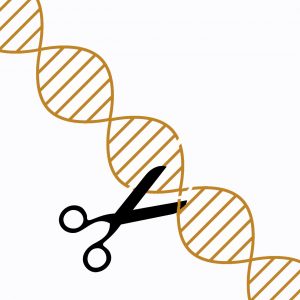Most of us have heard about genome editing/engineering and the ethical concerns surrounding the science. But while many immediately jump to thoughts of designer babies and new races of human, genome editing is still in its humble beginnings and could lead to some incredible scientific breakthroughs within the next few years.
Unless you work in a lab or do research that involves gene editing, odds are you’ve never heard the term CRISPR. CRISPR is a genome editing mechanism and a recent hot topic in the world of research science. First discovered in 1987, CRISPR was adapted from a natural mechanism used by bacteria. When invaded with a virus, bacteria take snippets of DNA from the invading virus and use it to create enzymes that destroy those same viruses if and when they reinvade. Essentially, bacteria take a DNA “snapshot” of the virus and use it against them. CRISPR acts in a similar fashion, adding, removing or altering snippets of the genome. It’s currently the fastest, most accurate and cheapest way to perform genome editing in the lab, making it a popular tool amongst scientists. So what does the use of CRISPR mean for the future of science?

One of the most exciting applications of CRISPR is in the research of human diseases. Already, CRISPR has been used in the research of cancer, heart disease, HIV, cystic fibrosis, hemophilia and more. Scientists use the mechanism in an attempt to remove or delete the genes responsible for said diseases or genes that play a role in their magnification. In a recent trial, scientists at the Oregon Health and Science University used CRISPR to successfully delete the defective genes that are known to cause Hypertrophic cardiomyopathy from 13 of 54 embryos that were at high risk of developing the disease. And while these results may not seem that positive, they’re a giant step towards tackling diseases before they even develop.
Of course, there’s still a lot of concern surrounding the ethical implications of genome editing and engineering the human genome. It’s important to note that CRISPR still isn’t 100% perfect. While it is the most effective and accurate method of genome editing that currently exists, it often “mis-edits”, removing DNA at the wrong area of the genome or inserting material incorrectly. On top of that, scientists still don’t know exactly how the entirety of the genome interacts. Removing or editing one part of the genome with CRISPR could lead to adverse reactions in other parts of the genome and unwanted effects. Just one of the many reasons CRISPR is still strictly used for research purposes. Practicing genome editing on embryos is also strictly regulated by law and is illegal in many places. Most CRISPR work is done on somatic cells, or cells other than the egg and sperm. Limiting genome editing to non-reproductive cells inhibits these edits from being heritable, removing the concern of a designer race.
But CRISPR isn’t only being used to edit the human genome. It’s also become a popular tool for creating more highly developed GMOs. Using CRISPR to create designer crops could potentially address the need for increased food sources as the human population grows, creating crops that are more nutrient dense, drought resistant and produce higher yields of food. It’s also an important mechanism in the race against constantly evolving deadly viruses like HIV. CRISPR can either be used to engineer cells that don’t allow viruses the break through or to engineer bacteria that are equipped to fight and destroy specific viruses. CRISPR is even being used as a tool to potentially resurrect extinct species…think Jurassic Park and frog DNA.
Whatever the application, CRISPR has become the scientific tool of the future and is well on its way to launching us into the genome editing, sci-fi future we’ve always imagined.

